Heavy metals are one of the major pollutants that contribute to the escalating problem of environmental pollution, being primarily introduced in sensitive ecological habitats through industrial effluents, wastewater, as well as sewage of various industries. Microbial bioremediation, particularly the use of bacteria, has gained attention due to the feasibility and efficiency of using them in removing heavy metals from contaminated environments. Bacteria have several methods of processing heavy metals through general resistance mechanisms, biosorption, adsorption, and efflux mechanisms. Bacillus spp. are model Gram-positive bacteria that have been studied extensively for their biosorption abilities and molecular mechanisms that enable their survival as well as their ability to remove and detoxify heavy metals.
- bioremediation
- Bacillus
- resistance
- microorganisms
- biosorption
- efflux
- heavy metals
1. Bioremediation—An Environmentally-Friendly Approach for the Removal of Heavy Metals
Bioremediation is a conventional process that employs the use of plants, animals, and microorganisms for the remediation of pollutants like heavy metals. It is one of most effective, non-invasive, and economically feasible methods for the permanent mitigation of heavy metal pollution and for the complete restoration of the natural environment of many ecosystems, as there is no production of secondary by-products [1]. Though methods such as phytoremediation (bioremediation using plants), phycoremediation (bioremediation using algae) and mycoremediation (bioremediation using fungi) have been widely reported in literature for heavy metal removal, our review focuses on bacterial bioremediation with
Bacillus
Bacteria are abundantly present in the environment, where their variety in shape, size, morphology, as well as resistance mechanisms makes them suitable for bioremediation of organic and inorganic pollutants. Biosorption mediated by bacteria is a cost-effective, economically feasible method for the removal of heavy metal ions and other pollutants from contaminated sites, as many species have evolved to develop mechanisms which mediate resistance to process heavy metal ions amidst high concentrations [2]. Over the past years, many bacterial species have garnered widespread attention for their potential ability to remove heavy metal ions from the environment, whereas bacterial biomass (live and dead) has also been investigated for biosorption of metal ions such as copper, chromium, zinc, nickel, cadmium, and mercury, concomitant on their interactions with the bacterial cell wall and related peptidoglycans [3][4][5]. Many bacterial species such as
Bacillus
Pseudomonas
Enterobacter
Flavobacterium
Geobacter
Micrococcus spp. have been investigated for potential use in biosorption of various heavy metal ions from contaminated sites, by observing their surface to volume ratio and other feasible characteristics which enhance the binding interactions between bacterial functional groups and heavy metal ions [6][7]. In a recent study, the biosorption ability of many bacterial species such as
B. subtilis
B
megaterium
A. niger
Penicillium
Bacillus spp. were observed to be the most efficient [8][9].
2. Bacillus Species and Heavy Metals
2.1. Arsenic
Arsenic (As) is a naturally occurring toxic metalloid [10] that is reported in soil (5–10 mg/kg), rock (1–2 mg/kg), sea water (1–3 µg/L) [11][12][13], as well as air and volcanic ash (0.02 µg/m
3
3) and methylated arsine species enter into the surroundings [14]. Its anthropogenic sources are herbicides, pesticides [15], fossil fuel combustion, mining, smelting, wood preservation, sludge, manure [16], paint pigments, ceramic, glass industry, and food additives [17][18][19]. It exists as insoluble sulfides and sulfosalts [20]. It has four oxidation states: As
3-
0
3+
5+
3+
5+
3+
5+, which is mostly adsorbed to the sediments in an anoxic state [21][22]. The histidine part of cellular proteins is a target site for the interaction of thiols of cysteine residues and/or imidazolium nitrogen with As
3+, which results in the inactivation of enzymes [23]. As
5+ interferes with protein synthesis by replacing the phosphate group during phosphorylation of the energy transfer process. The existence of either state depends on the redox state of the environmental conditions [24], as well as the geomicrobial population [25]. The US EPA and WHO has allowed 10 µg/L as the permissible concentration of As in drinking water [16]. Above 0.5 ppm, it is toxic for living systems resulting in symptoms of skin cancer [26], loss of appetite, weakness, weight loss, lethargy, chronic respiratory disorders, gastrointestinal disorders, enlargement of liver, spleen disorders, anemia [27], and cardiovascular disease [28]. Introduction of arsenic into the food chain and ground water may lead to serious concerns of arsenicosis [22].
Bioregulation of Arsenic by
Bacillus
spp.
The soluble nature of As makes its removal from the environment difficult [29]. Physical and chemical remediation of arsenic involves an oxidation step for converting As
3+
5+. It may occur under atmospheric oxygen, which is usually very slow, or by using chemical oxidants like hydrogen peroxide, chlorine, or ozone. This method is very expensive and produces harmful byproducts [30]. Microorganisms use As as an energy source in their metabolic processes and thus transform the toxic As
3+
5+ [31][32] by arsenic oxidase, which is present in the protoplasm of arsenic-oxidizing bacteria [10]. Liao et al. [33] reported
Bacillus
Bacillus
B. aryabhattai [36], and
B. cereus strain W2 was studied by Miyatake and Hayashi [37]. Anaerobic respiration of As
5+
B. cereus was reported by Ghosh et al. [22]. Various other studies conducted over the years have reported the ability of
Bacillus spp. to uptake As [38][39][40][41][42] (
Table 1). As speciation, solubility, and mobilization are dependent on its methylation [43][44], oxidation [45], reduction, and respiration. The significance of oxidative phosphorylation in living organisms cannot be ignored [19]. Structurally, As
5+ has similarity with phosphate [16]; thus, it is a potential oxidative phosphorylation inhibitor [19]. As
5+ enters the organism’s living system by employing two pathways; Pit and Pst [45], which are usually used for phosphate uptake. It interferes with phosphorylation metabolic reactions and inhibits synthesis of adenosine triphosphate [10]. The portal of entry for As
3+ is aquaglyceroporin proteins [16][46][47]. After internalization, it immediately binds to the respiratory enzymes via their sulfur residue [17][48]. Bioremediation of As in
Bacillus
ars operon [49] (
Table 2
arsA
arsB
arsC
arsD
arsR
arsA
arsB
arsC
3+
5+
arsD
arsR acts as a repressor [50][51][52][53]. Normally, As
5+
3+ (more toxic form) by ArsC and then transported out of the cell by ArsB [54][55] (
Figure 1
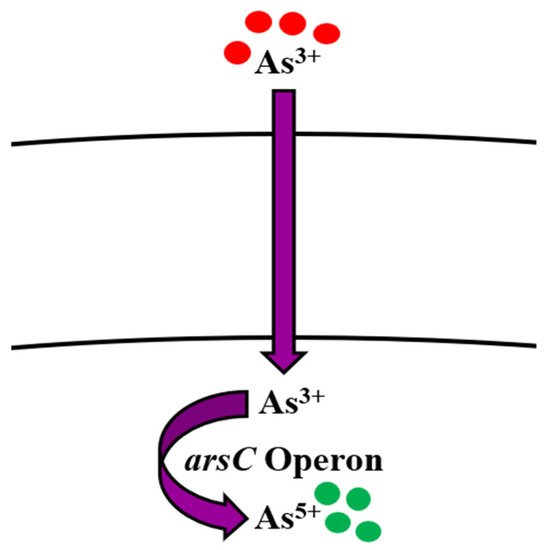
Figure 1.
Bacillus
Table 1.
Bacillus
| Metal | Bacterial Strains | Initial Metal Concentration (%/mg/g/mM/ppm/mg/L) |
Metal Uptake Ability (%/mg/g/mM/ppm/mg/L/mol/g) |
Reference |
|---|
| Arsenic |
Bacillus
| Metal | Protein(s)/Gene(s) | Method(s) | Reference | |||||
|---|---|---|---|---|---|---|---|---|
| Bacillus | sp. KM02 | 100 ppm | ars operon (arsR, arsD, arsA, arsB, arsC) | Reduction (Detoxification) Efflux Cell membrane binding, Adsorption on cell surface Complexation by exopolysaccharides51.45% (As3+) |
[10][32][38][50[53][10][59] | |||
| [ | 59 | B. licheniformis B. polimyxa |
0–100 mM 0–20 mM |
100 ppm (As0) 100 ppm (As0) |
[39][88] | |||
| Bacillus sp. IIIJ3–1 | 350 smM (As5+) 10 mM (As3+) |
350 mM (As5+) 10 mM (As3+) |
[22][71] | |||||
| B. barbaricus | - | 20 mM (As5+) 0.3 mM (As3+) |
[42][91] | |||||
| , | 161 | , | 162,163,164,165 | B. indicus Sd/3T | 0 mM 0 mM |
20 mM (As5+) 30 mM (As3+) |
[40][89] | |
| ] | ||||||||
| Lead | pbr operon | Efflux | [117][118][119][166,167,168] | B. selenatiredreducens | 10 mM | |||
| Copper | CueR copZA operon (CopA, CopZ, CopB) | 0 mM (As5+) 0.3 mM (As3+) |
YcnJ[38][87] | |||||
| Efflux by chaperone | Uptake | [120][121][122 | B. arsenicus con a/3 | 20 mM 0.5 mM |
20 mM (As5+) 0.3 mM (As3+) |
[41][90] | ||
| B. cereus W2 | 50 mg/L | 1.870 mg/L (As3+) | [37][86] | |||||
| B. cereus EA5 B. fusiformis EA2 |
15 mg/L | 94.9% 99.7% |
[35][84] | |||||
| B. arsenicus MTCC 4380 | 2000 mg/L 1800 mg/L |
89.462% (As5+) 83.043% (As3+) |
[43][92] | |||||
| Zinc | B. subtilis | 178 mg/L | 49.7 mg/L | [56][105] | ||||
| Bacillus sp. (KF710041) B. subtilis (KF710042) |
- | 73.29% 78.15% |
[57][106] | |||||
| B. licheniformis | - | 53% | [58][107] | |||||
| B. cereus | 0–200 mg/L | 66.6 mg/g | [59][108] | |||||
| B. jeotgali | 75 mg/l | 30% | [60][109] | |||||
| B. subtilis D215 | 100 mg/L | 63.73% | [61][110] | |||||
| B. firmus | 100 mg/L | 61.8% | [62][111] | |||||
| B. altitudinis | 100 mg/L | 87 mg/L | [63][112] | |||||
| Nickel | B. subtilis | 2.14 ppm | 85.61% | [64][113] | ||||
| B. subtilis BM1 B. subtilis BM2 B. subtilis BM3 |
2–32 mg/L | 98.54% 99.2% 96.3% |
[65][114] | |||||
| B. subtilis | 178 mg/L | 57.8 mg/g | [56][105] | |||||
| Bacillus sp. KL1 | 100 ppm | 55.06% | [66][115] | |||||
| B. thuringiensis KUNi1 | 0–7.5 mM | 82% | [67][116] | |||||
| B. thuringiensis OSM29 | 25–150 mg/L | 94% | [68][117] | |||||
| B. thuringiensis | 250 mg/L | 15.7% | [69][118] | |||||
| Cadmium | B. safensis | 40 ppm 60 ppm |
83.5% 98.10% |
[70][119] | ||||
| B. licheniformis | - | 98.34% | [71][120] | |||||
| B. catenulatus JB-022 | 150 mg/L | 66% | [72][121] | |||||
| B. thuringiensis DM55 | 0.25 mM | 79% | [73] | |||||
| [ | ||||||||
| 82 | ||||||||
| ] | ||||||||
| [ | ||||||||
| 131 | ||||||||
| ] | ||||||||
| B. subtilis D215 | 100 mg/L | 67.18% | [61][110] | |||||
| , | 81 | ] | [,8751][,9952,100],101,102][ | B. sphaericus B. cereus Bacillus sp. |
17.6 mg/L 44.0 mg/L 88.0 mg/L |
5.6 mol/g 5.9 mol/g 6.4 mol/g |
[83][132] | |
| Bacillus sp. SG-1 | - | 60% | [84][133] | |||||
| Chromium | B. cereus NWUAB01 | 100 mg/L | 43% | [85][134] | ||||
| ] | B. cereus | 100 mg/L | 81% | [86][135] | ||||
| 123 | ] | B. salmalaya 139SI | 50 ppm | 20.35 mg/g | [87][136] | |||
| B. cereus FA-3 | 1000 μg/ml | 72% | [88][137] | |||||
| B. licheniformis | 15 mg/L | 95% | [89][138] | |||||
| Bacillus sp. B | 500–4500 mg/L | 47% | [90][139] | |||||
| B. marisflavi | 200 mg/L | 5.783% | [91][140] | |||||
| [ | 169 | , | 170, | B. licheniformis | 300 mg/g | 69.4% | [92][141] | |
| B. thuringiensis | 250 mg/L | 83.3% | [93][142] | |||||
| B. licheniformis B. laterosporus |
- | 62 mg/g 72.6 mg/g |
[94][143] | |||||
| B. circulans B. megaterium |
0.96 mg/L | 34.5% 32% |
[95][144] | |||||
| Mercury | B. thuringiensis CASKS3 | 200 mg/L 400 mg/L 600 mg/L |
62.4% 54% 40% |
[96][145] | ||||
| B. licheniformis | 50 mg/L | |||||||
| B. cereus | ||||||||
| 5 mg/L | 104.1 mg/g | [ | 100][149] | |||||
| Bacillus sp. | 1–10 mg/L | 7.9 mg/g | [101][150] | |||||
| Manganese | B. thuringiensis HM7 | 400 mg/L | 95.04% | [102][151] | ||||
| B. cereus HM-5 | 600 mg/L | 67% | [103][152] | |||||
| Bacillus sp. | 13.3 mg/g | 55.56 mg/g | [104][153] | |||||
| Molybdenum | Bacillus | |||||||
| Zinc | Zur ZosA ycdHI-yceA yciABC CadA CzcD |
Physico-chemical adsorption Ion exchange Efflux Uptake |
[59][108][109][108,157,158] | |||||
| Nickel | CzcD CitM |
Effluxsp. Zeid 14 | - | 200 mg/L | [105][154] | |||
| Bacillus sp. strain A.rzi | 0.1 mM | Not reported | [106][155] | |||||
| [ | 110 | ] | [111][159,160] | |||||
| Cadmium | cad operon yvgW KinA |
Efflux | [73][85][112][113][114][115][116][122,134171,172] | |||||
| Chromium | ChrR | Efflux, Uptake Enzymatic reduction (Detoxification) |
[124][125][126][173,174,175] | |||||
| Mercury | mer operon (merR, merA, merB) MerR MerA MerB |
Efflux Enzymatic reduction (Detoxification) |
[127][128][129][130][131][176,177,178,179,180] | |||||
| Manganese | mntABCD operon MntR MntH MneP MneS |
Efflux Uptake |
[132][133][134][135][181,182,183,184] | |||||
| Molybdenum | modABC operon | Uptake | [99][136][137][138][139][140][141][148,185,186,187,188,189,190] | |||||
| Gold | Not reported | Bioaccumulation | [142][143][191,192] | [ | ||||
| Silver | SilP | 122 | ] | |||||
| sil | genes | Efflux | [144][145][146][147][148][149][193,194,195,196,197,198] | Lead | B. pumilus MF472596 | 100–1000 ppm | 96% | [74][123] |
| B. subtilis X3 | 200–1400 mg/L | 590.49 mg/g | [75][124] | |||||
| B. cereus | 5–100 mg/L | 36.71 mg/g | [76][125] | |||||
| Bacillus S1 Bacillus SS19 |
75 and 100 mg/L 50 mg/mL |
53%, 51% 57% |
[77][126] | |||||
| Bacillus sp. AS2 | 500 ppm | 74.5 mg/g (99.5 %) | [78][127] | |||||
| Copper | B. cereus | 100 ppm | 54% | [79][128] | ||||
| B. cereus | 400 ppm | 48% | [80][129] | |||||
| B. thuringiensis OSM29 | 25 mg/L | 91.8% | [68][117] | |||||
| B. licheniformis | 5 gm/L | 32% | [81][130] | |||||
| B. thioparans | 40 mg/L | 27.3 mg/g70% | [97][146] | |||||
| B. cereus BW-03(pPW-05) | 5–50 ppm | 96.4% | [98][147] | |||||
| B. licheniformis | 100 μg/mL | 70% | [99][148] | |||||
| Silver | B. licheniformis R08 | 100 mg/L | 73.6 mg/g | [107][156] |
Table 2.
| Arsenic |
2.2. Zinc
Zinc (Zn) is one of the most profusely abundant transition elements in the Earth’s crust, and is also widely found in biological systems, coming second only to iron. Zn (atomic number 30) is a member of group XII (previously known as II-B) of the periodic table of elements, and as analogous to all members of the group, it is also characterized as a divalent metal [150]. At room temperature, it occurs as a brittle, lustrous metal with a blue-white hue [151]. In reactions concerning hydrolysis, Zn tends to act as a Lewis acid or electrophile, which catalyzes these reactions and is thereby integrated into assorted metallo-enzymes, transcription factors, and regulatory proteins [152]. In cells, it exhibits antioxidative properties against the formation and mitigation of free radicals and reactive oxygen species, which contributes to the perpetuation of protein stability. The significance of Zn resonates with its function as an essential nutrient in living systems, augmenting its presence in both human beings and bacteria, where more than 5% of bacterial proteins evince their dependency on Zn [153]. These manifold functions preponderate over its toxicity at higher concentrations in cells, which can often be promoted by the blockage of protein thiols via mis-metallation with other metals, resulting in the disruption of various biological functions [154].
In the environment, anthropogenic actions have shaped the presence of Zn and its compounds in industrial and agricultural wastewaters, underscoring the production (more than 12 million tons annually) and then consumption of Zn in a multitude of processes such as galvanization, metallurgy, and the pharmaceutical industry, alloy metal casting, pesticides, and production of several other consumer goods [155]. Moreover, mining activities and contamination of sludge in soils poses a considerable threat of Zn toxicity to the sustainability and quality of crops [156], which further raises concern for the purification of contaminated sites by effective methods. It has been reported that the removal of Zn in low concentrations is mediated by physical and chemical methods, but its removal by biological agents (plants, algae, microorganisms) is a method which has been gaining attention due to its many advantages that eclipse its drawbacks. The treatment of Zn-contaminated wastewaters through plants, biomass, sawdust, mollusk shells, fruit and vegetable peels, agricultural wastes, and polysaccharides such as chitosan and pectin as potentially effective biosorbents has been widely reported [157][158].
Bioregulation of Zinc by
Bacillus
spp.
Bacillus
Bacillus spp. is regulated either by acquiring resistance through plasmids or by evolving mechanisms of resistance [159][160]. In
B. subtilis, Zn uptake is regulated by the Zur family, which enables the transport of Zn ions via two transporter proteins. Gaballa et al. [108] also reported a third uptake system in
B. subtilis
B. subtilis, known as CadA [108][109] (
Table 2
Figure 2
Bacillus
B. subtilis
B. licheniformis
B. cereus
B. jeotgali
B. firmus was reported in recent studies [56][57][58][59][60][61][62] (
Table 1). Khan et al. [63] also reported the removal of Zn (87 mg/L) by
B. altitudinis
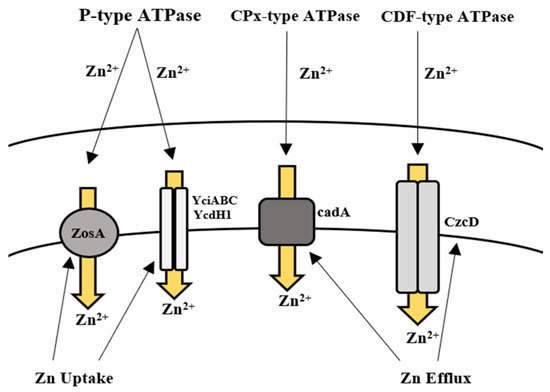
Figure 2.
Bacillus
2.3. Nickel
Nickel (Ni) belongs to group 10 and is the 28th element in the periodic table, discovered by Swedish chemist Axel Cronstedt in its purified form for the first time in 1951. It is a hard, silvery-white transition metal which belongs to the ferromagnetic group of metals with high electrical and thermal conductivity [161]. It is the 24th most copious element found in the Earth’s crust, and the 5th most abundantly found in terms of weight. It is naturally found in its oxidation state (2+) which is analogous to most environmental and biological settings, though it may exhibit other valences as well (−1 to +4) [162]. It persists in nature in its hydroxide form at pH > 6.7, while its complexes appear to be readily soluble at pH < 6.5. It is found to exist in various forms of air- and water-resistant minerals (oxides and sulfides) [163], which give rise to Ni salts of strong (readily soluble in water) and weak acids (poorly soluble in water), respectively [164]. Natural sources of Ni in the environment are attributable to soil and rock erosion, volcanic eruptions, meteorite emissions, air-blown dust, as well as foods [165]. Combustion of fossil fuels and leaching from rocks and soil contribute to its presence in air and water, respectively. Moreover, anthropogenic emissions in the form of metal smelting and mining, metal refineries, Ni plating and alloy production, and effluent and sludge disposal into soil and water catalyze its presence in high concentrations in the environment [166]. The commercial use of Ni and its extensive applications such as production of Ni-Cd batteries, use in jewelry, orthodontic equipment, machinery, coins, food processing, clothing, and electronics promote its ubiquity in the environment, where it exists as sulfides, oxides, and less frequently, in its metallic form [167]. Ni toxicity has been the subject of widespread research in humans, where it is highlighted that the metal poses no considerable nutritional value in humans and poses industrial and occupational hazardous risk [168]. Nevertheless, it has been characterized as essential for the growth of plants, microorganisms and animals [169], where Ni-based enzymes and cofactors are reported to serve a key role in their function [170].
Bioregulation of Nickel by
Bacillus
spp.
There have been many methods of Ni removal from solid matrices, but the most effective are those which are capable of removing/treating Ni before it emanates into the environment [171]. Several physico-chemical methods have been employed over the years for the removal of Ni from aqueous solutions [172]. Regardless of which of these methods have been used in the past, newer, cheaper, and more efficient methods of adsorption have been used for Ni removal, such as the use of biomass, where sugarcane, corn cobs, citrus peels, and bark have been used [173]. In a study, corn hydrochar was treated with KOH and altered by treating polyethyleneimine (PEI) to increase adsorption of Ni ions onto the surface [174]. Bioremediation by Gram-positive bacteria, such as
Bacillus spp., has been the better method for the removal of Ni ions from Ni-contaminated media. There have been many studies that demonstrate the uptake and/or removal of Ni ions from contaminated environments such as soils, wastewater, and rivers [56][64][65][66] (
Table 1
B. thuringiensis has also been frequently reported to uptake and remove Ni from contaminated environments [67][68][69]. In a recent study,
B. megaterium was isolated from Ni-contaminated soils and was able to uptake more than 500 mg Ni, where more than 3000 mg/L Ni salt was previously found [175]. The removal of Ni by bacteria is contingent on their inherent mechanisms of resistance, which ultimately facilitate uptake, transportation, and efflux of the metal ions in and out of the cell. According to Moore et al. [110], mechanisms of Ni homeostasis and regulation have not been well characterized in
B. subtilis
Escherichia coli
Helicobacter pylori, though some evidence suggests their presence [176]. Members of the cation diffusion facilitator (CDF) family have long been characterized to mediate efflux of multiple metal ions, including Ni [111]. In
B. subtilis
2+
+
2+
2+ [110] (
Figure 3
B. subtilis, consequently leading to an increase in toxicity to them [110] (
Table 2
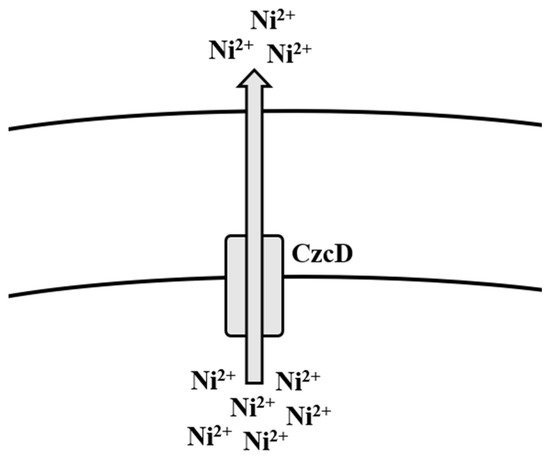
Figure 3.
Bacillus
2.4. Cadmium
Cadmium (Cd) is a member of group XII of the periodic table and is a silvery white metal in appearance, with physical and chemical properties similar to both zinc and mercury. It exists in general oxidation state (+2) and is malleable and ductile. Cd is a corrosion-resistant metal, which is not flammable and water-soluble in nature, and is generally regarded as a toxic heavy metal with wide application in the industries of batteries, plating, plastics, and pigments, contributing greatly to its toxicity [170]. Anthropogenic activities have led to its presence being observed in many food sources and drinks [177]. Cadmium oxide is often used in metal plating, catalysis, and ceramic glaze. Alongside cadmium telluride, it has been also used in the form of a thin film for use in diodes, transistors, solar cells, electrodes, and anti-reflective coatings [178]. Cd is also used extensively in industrial strength paints, which can pose an environmental hazard during spraying. Other sources of contamination such as Cd-containing fertilizers can pollute soils which can inadvertently enhance its absorption by humans and other living beings. Cd has no known biological function and is a great threat to all life forms [179], due to which its environmental exposure can be dangerous, and in some cases, fatal [180].
Bioregulation of Cadmium by
Bacillus
spp.
cadA
cadA
cadA is transcribed into the 727-amino acid protein, which performs the function of energy-dependent Cd efflux ATPase [85], whereas
cadC
2+ operon [182][183]. It is well reported that
cadA
2+ ions. Solovieva and Entian [112] documented their findings on
cadA
yvgW
B. subtilis
2+
cadA
S. aureus plasmid pI258 [184]. Deletion of
yvgW
2+
cadB
2+ resistance through a change in the binding site [113]. In addition to efflux mechanism, KinA and histidine kinase provide phosphate for phosphorylation which leads directly to transcription in
B. subtilis [114]. Its overexpression results in phosphate flux of the cell, thereby directly affecting the energy state of the cell wall [185]. It also plays a significant role in biosorption of Cd
2+
Bacillus cell surface magnitude, hence it acting as a major phosphate provider [73]. Cd
2+
2+
2+
2+ concentration is high [186]. The
cad
Bacillus megaterium
2+
2+ metal binding motifs [187]. On exposure to metal ions, the first interaction is always with cell wall [188]. Its structure and composition play a significant role in deciding the next step of the process. Cd
2+
2+
2+
+ ions [189]. Chelation is another process in which Cd
2+
3H, –COOH, and –NH [190]. It involves sequestration via intracellular metallothionein (MT) [191]. Inorganic deposition of Cd
2+ in the cell wall or inside cells can take place through interaction with hydroxide, carbonate, sulfate, and phosphorus [192]. In addition to metal concentration, biosorption is dependent on cell wall composition and cell physiology [193]. In Gram-positive bacterial species, resistance to Cd
2+
cadA
2+ enters the bacterial cell by the MIT (metal ion transporter) system [115][116] (
Table 2
2+ resistance are mostly plasmid-mediated. According to Chen et al. [194] they are found on R plasmid along with antibiotic resistance genes, e.g., in pathogens including
K. pneumoniae
P. aeruginosa
S. aureus
2+
Figure 4). Basha and Rajaganesh [71] reported
B. licheniformis
2+
2+
B. catenulatus
B. safensis
Table 1
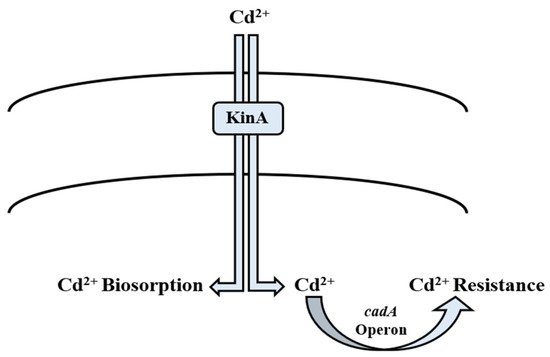
Figure 4.
Bacillus
2.5. Lead
Lead (Pb) is a toxic heavy metal that is introduced into the environment via the weathering of rocks. Anthropogenic sources include fossil fuels, extraction and melting of metals, battery-manufacturing industries, insecticides, pigments, and fertilizers [195]. Tetraethyl lead (TEL) has a common application as a gasoline additive, due to which it is a source of heat and electricity [196]. It exists in two states: Pb
2+
4+ [197]. Its toxicity determines its bioavailability as well as mobility in the soil. Its common forms are oxides, hydroxides, ionic form, metal oxyanion complexes [151], phosphates, and carbonates (at pH above 6). The stable and insoluble forms include oxides, sulfides, and pyromorphites [198]. Its exposure occurs by food, water, and inhalation, which affects the circulatory, gastrointestinal, reproductive, neurological, muscular, kidney, and genetic systems [74]. Dose and exposure time are prime factors [199]. The permissible level of Pb in drinking water is <10 µL/L [182].
Bioregulation of Lead by
Bacillus
spp.
Bacillus spp. have been reported previously [197].
Bacillus
pbr operon [117][118][119] and active transport [200] as potential strategies to combat the toxic effects of Pb (
Table 2
Figure 5
2+ is exchanged by Na or K cations [75]. Another method is adsorption through the cell wall, as it is comprised of organic macromolecules including polypeptides, polysaccharides, and proteins, which have the ability to adsorb Pb via electrostatic forces including Van der Waal’s forces, covalent or ionic bonds [75]. Pb interferes with microbial growth, morphology, and biochemical activities by damaging the DNA, protein, and lipids and even replacing the essential ions within the enzymes [74][201]. Microbes resist Pb toxicity by extracellular precipitation, exclusion, volatilization, biomethylation, cell surface binding, intracellular sequestration, and enhanced siderophore production [74]. Much like other Gram-positive bacteria,
Bacillus spp. also employ one or several of these methods to remove Pb from the contaminated environments [76][77][78] (
Table 1
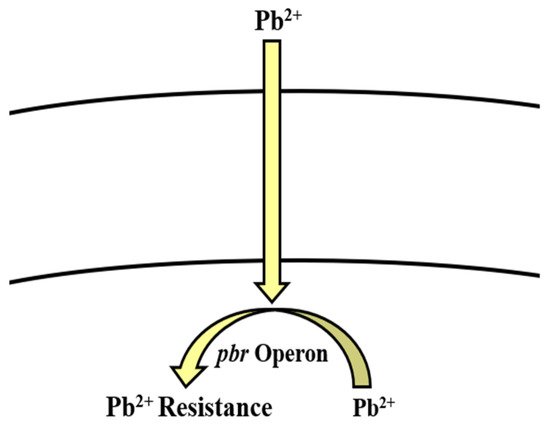
Figure 5.
pbr
Bacillus
2.6. Copper
Copper (Cu) is categorized into the group I-B, and period 4 of the periodic table [151]. It is a soft, diamagnetic, malleable, and ductile metal with remarkable electrical and thermal conductivity. It acts as a soft and intermediate Lewis acid and tends to bind to soft bases (hydride, alkyl, thiol, phosphine) and auxiliary ligands to Cu
2+, such as sulfate and nitrate [202]. Apart from being widespread in the environment thanks to anthropogenic actions, it also exists naturally in the form of minerals such as sulfides, carbonates, and oxides. The discovery and use of Cu dates back to ancient times, with its use spanning more than five thousand years. It exists in either of its two oxidation states, which can be the oxidized, divalent cupric form (Cu
2+
+) [203]. The significance of Cu in biological systems is pivotal; it serves an important role as a micronutrient in several biological processes in both prokaryotic and eukaryotic organisms. However, this stands only for lower concentrations of the metal; higher concentrations tend to induce cell toxicity, resulting in intracellular damage including changes in DNA, respiration, and overall growth [204]. Moreover, Cu is essentially required as a co-factor in more than thirty known enzymes, due to its ability to reversibly interconvert from its less to more required forms very easily [205]. Elevated levels of Cu exposure are a deep-rooted cause of environmental pollution by Cu, the fundamental reason being anthropogenic processes. Industries using Cu or its compounds, Cu mining, burning of fossil fuels, inadequate treatment of wastewater, accumulation in dumps, production of phosphate-containing fertilizer, and natural processes such as erosion, volcanic eruptions, forest wildfires, and decay are all processes which greatly contribute to its presence in the environment. Furthermore, its production is also a source of direct Cu pollution, capable of harming the fragile ecosystems of soil, water, and air, respectively [206].
Bioregulation of Copper by
Bacillus
spp.
Bacillus subtilis
B. thuringiensis
B. cereus
B. licheniformis
B. sphaericus are also involved in the removal of Cu, when their concentrations exceed the required limit [68][79][80][81][82][83][84][207][208] (
Table 1). In correlation with other bacterial species, Cu in the cytosol is regulated by CueR [209].
B. subtilis
copZA operon which encodes both Cu chaperone and a P-type ATPase for Cu efflux, the latter of which is a member of the integral family which exports metal out of the cell [120]. In the former, CopZ plays a key role as Cu chaperone in transferring Cu over to CopA [121], which contributes to uptake of Cu, while CopB is accountable for Cu efflux and detoxification [122] (
Table 2
Figure 1). Chillappagari et al. [123] reported that YcnJ was associated with Cu uptake function of
copZA
B. subtilis
Figure 6

Figure 6.
Bacillus
